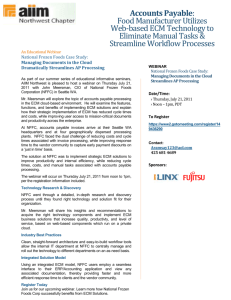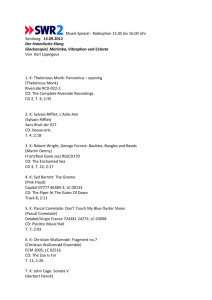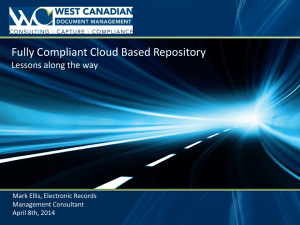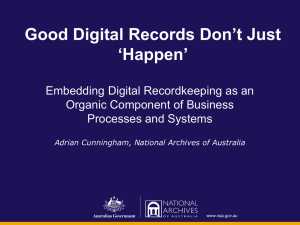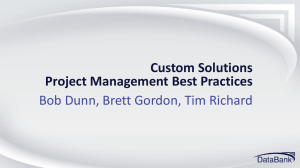2014-07-01 - ECM Compliance (Marcelle Blasl)
advertisement
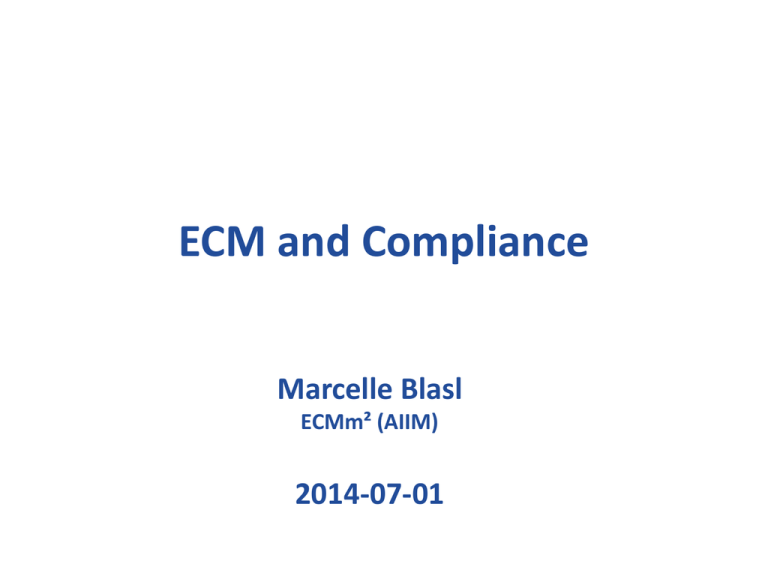
ECM and Compliance Marcelle Blasl ECMm² (AIIM) 2014-07-01 Agenda • • • • • Compliance Overview ECM Records Management Compliance in Context Q&A Compliance The act or process of doing what you have been asked or ordered to do. To act according with any acceptable standard or criteria. The “acceptable standard” can refer to any kind of criteria including business goals, performance measurements, laws, regulations or quality targets. A level of quality, achievement, etc., that is considered acceptable or desirable. • Merriam-webster dictionary Why Compliance? Transacting business is evident in the records of such activities. • Non-Compliance to legislation e.g. Section 13 of NARS Act dealing with management of records • Non-Conformance to Audits with respect to records keeping Audit: – Unqualified / Clean – Qualified – Disclaimers It is all about the records Compliance? • Regulatory drivers – – – – – – – – – – – – Companies Act National Archives of South Africa Act (Act No 43 of 1996) (NARS) Promotion of Administrative Justice Act (Act No 3 of 2000) (PAJA) Promotion of Access to Information Act (Act No 2 of 2000) (PAIA) Electronic Communications and Transactions Act, (Act No 25 of 2002) (ECT) DPSA Regulations regarding Information Management Public Finance Management Act, 1999 (PFMA) Municipal Finance Management Act, 1999 (MFMA) Sarbanes-Oxley (SOX) King 3 Protection of Private Information (POPI) Other organisation specific • Government Drivers – The Constitution of the Republic of South Africa, 1996 Section 32 – White Paper on e-Government – The Batho Pele White Paper (“People First”) Regulations Industries 450 400 350 300 250 200 150 100 50 0 Private Government Financial Estimated Medical Construction Mining Compliance continued • Internal drivers – Lacks formal policies and standards and standardised structures for the management of information and records – Problems to retrieve documents and information – Insufficient security – Problems with reporting and auditing – Lack of good corporate governance on records and information management – Lacks accountability – no CIO or records manager as specified in MFMA and PAIA Acts – Cumbersome processes and approvals – Non compliance with legislation open to risk (PFMA, PAJA , PAIA Acts) – Performance Management – Filing space problems – Backlogs of filing in registries – Business operations at risk with lack of a disaster recovery plan regarding all records under its control • External drivers – The public demands better services – Other similar organisations are doing it better (competition) – Emerging technologies (many products and vendors) ECM Enterprise Content Management (ECM) Solution is the strategies, methods and tools used to capture, manage, store, preserve, and deliver content and documents related to organizational processes. High-Level ECM Architecture Policies Information Management Policy Records Records Managemnt Management Policy Policy Enterprise Content Management (ECM) Policy Records Centre Policy Archiving Policy Internet Policy Intranet Policy Other Affected Policies Social Media & Collaboration Printing / Copying Policy E-Mail Policy Telephone policy Digital Signatures / Approval Policy Scanning Policy Information Security Policy Information Classification Policy Good Records Keeping According to the NARSSA records management is: A process of ensuring the proper creation, maintenance, use and disposal of records throughout their life cycle to achieve efficient, transparent and accountable governance Records Management SANS (ISO) 15489 Information and documentation – Records management Section 13 S.13(1) S. 13(2)(a) S. 13(2) S.13(2)(b)(i) S. 3(5) S. 13(2)(b)(ii) and (iii) Section 13 (1) • Mandates National Archivist to regulate records management practices • Aligned with international best practice and international standards – SANS (ISO) 15489 Information and documentation – Records management • supports the records management requirements in section 13 of the National Archives and Records Service Act Section 13 (5) Designate a records manager to take responsibility for the records management practices and to ensure that the office complies with the National Archives Act Section 13 (2) (a) • No public record shall be : - transferred - destroyed - otherwise disposed of • without written authorization of the National Archivist Section 13 (2) (b) (i) The National Archivist shall determine the records classification systems to be used by governmental bodies File Plan A plan to file records • Paper environment – File into physical folders opened according to the File Plan • Electronic environment – Metadata • Structured • Visible Section 13 (2) (b) (ii) and (iii) • The National Archivist shall determine the conditions subject to which – electronic records systems shall be managed – records may be reproduced electronically • Conditions contained in Managing electronic records in governmental bodies: Policy, principles and requirements Conditions for the management of electronic records • From a records management perspective – Capturing of authentic and reliable records (authoritative records) – Subject classification – Retrieval – Disposal – Long term preservation Manage records in an Integrated Document and Records Management System • managing a corporate file plan according to which records are filed; – Including an e-mail integration that ensures that emails are filed to the corporate file plan; • maintaining the relationships between records and files, and between file series and the file plan; • identifying records that are due for disposal and managing the disposal process; Manage authenticity • Metadata – Guidelines in Managing electronic records in governmental bodies: Metadata requirements – Based on SANS 23081: Information and documentation – Records management processes – Metadata for records – Part 1: Principles Manage authenticity • Audit trail – Guidelines in Managing electronic records in governmental bodies: Metadata requirements – Based on SANS 15801: Electronic imaging – Information stored electronically – Recommendations for trustworthiness and reliability Long term accessibility • Electronic records preservation plan – Technology watch – Migration – Budget Conclusion If it cannot be read, it does not exist Financial Resources- People Data and Information Security and Access Control Technology & Infrastructure Business – Processes Regulatory ECM Compliance RM Standards Standard Compliance US DoD UK RIMTech Fortune 1000 Victoria Public Records Office ICA ISO 15489 168 NARSSA 441 105 105 275 SP2013 OotB NARRSA (441) ICA (275) Baseline US DoD 5015.2 (168) Fortune 1000 (105) SP OotB (72) Differences Technology • Out of the Box implementation does not give adherence to compliance • Customisation does not guarantee compliancy • Require 3rd party tools Managing Compliance 1. Determine what the criteria should be 2. Develop techniques (controls) to ensure that the criteria are followed 3. Identify the risks that an organisation faces and advise on them 4. Design and implement controls to protect an organisation from those risks (prevention) 5. Monitor and report on the effectiveness of those controls in the management of an organisations exposure to risks (monitoring and detection) 6. Resolve compliance difficulties as they occur (resolution) 7. Advise the business on rules and controls (advisory) References: http://www.national.archives.gov.za http://www.rimtech.ca/f1000-requirements.html http://www.gimmalsoft.com Marcelle Blasl blasl@global.co.za Cell: 082 859 1507


